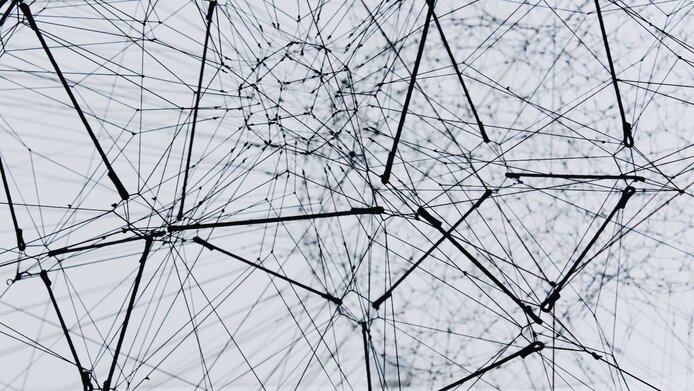How a coincidence helps to control the pandemic

When Stefan Thurner published a scientific paper on the spread of epidemics in social networks in 2018, he could not have guessed that he would receive a call from the Austrian ministry of health two years later. The ministry invited him to contribute his expertise to a team of scientists assigned to advise the minister in order to gain control over the effects of the worst pandemic since the Spanish flu in Austria. Named Austria's Scientist of the Year 2017, Thurner actually engages in basic research with a particular focus on complex systems. At the time, his kind of models, which investigate epidemics in networks of people, were considered to be of rather academic interest, as hardly more than a model system interesting mainly for its structure. Thurner's team chose an unusual approach, taking into account that people change their social behaviour when they are confronted with people who are ill. This had never been done before. “We didn’t know then, but we actually hit the nail on the head with our approach,” says Stefan Thurner. "We had developed a model for self-directed social distancing.”
Different approach
For his paper, which was published in a physics journal, the researcher used the so-called SIS equations, whereby S stands for susceptible to infection and I for infected. “We didn't approach this in the same way as everyone else did, but assumed that along with infection numbers there would also be a change in social networking. For instance, someone will not meet their friends if they know they're infected.” These are precisely the mechanisms that are relevant right now. Social network mutability makes the situation complex and thus particularly interesting to Thurner. Systems of that kind are strongly “non-linear”, as mathematicians would put it, and tend to behave chaotically – a characteristic they have in common with meteorological models or simulations of the financial market. Small changes in the parameters can have big effects, similar to the proverbial beating of a butterfly’s wing that can trigger a hurricane.
Early warning system
Thurner uses the term “co-evolving” systems: the number of infected people changes the social network, the social network in turn changes the number of people infected. According to Thurner, such situations are currently popular in basic research because they are very difficult to calculate and, as of now, not a lot of work has been done on them. “We were interested in finding out whether there could be an early warning system capable of predicting at what point the social network would fall apart.” Thurner and his team were actually able to identify parameters that could warn of such a collapse. “We weren't thinking about coronaviruses at the time, if anything we had Ebola in mind," Thurner says, but notes that the mathematics is very similar. Relying on these and similar models, Turner's group is able to make accurate predictions of infection rates one to two weeks into the future.
Vulnerable points in supply chains
Funded by the Austrian Science Fund FWF, Thurner’s basic research project, which provided the basis for this approach, produced yet another result of current relevance that was recently published in the journal Nature Scientific Reports. Thurner and his colleagues focused on economic cycles, for instance in the food sector. During the current crisis, a disruption of supply has become a scenario that needs to be taken seriously. By way of example Thurner points to the collapse of the meat-processing sector in the USA, where a quarter of the meat supply is suddenly missing. Weaknesses in supply systems that eventually lead to a breakdown could often only be identified when it was already too late. Early warning systems are needed in this context as well, but so far the network still needs to be well understood. Turner's team has now succeeded in proving a general mathematical theorem that enables the early detection of system weaknesses. This works even if only the network nodes – such as the properties of the production plants – are known, but not their relationships to each other. The astonishing result is that certain variables in the system suddenly become “quantized”, i.e. they can only take values that are integer multiples of each other. In concrete terms, this would mean that observing the revenues of supply chains can provide indications of their vulnerability: if the revenues of one company are suddenly twice or three times those of another, this is a sign that only one single functioning economic cycle is protecting the system from collapse. The bottleneck could then be identified and protected in good time. The three-year FWF project is scheduled to run until the end of this year.
Realistic simulation
Thurner points out that this work differs from models as they have been commonly used over the past ten years. The latter, so-called agent-based models, were often not designed to depict real-world processes in a truly realistic manner. By now, researchers can feed such models with realistic input data – “calibrating” them, in a way – and are thus able to evaluate how well they reflect reality. Thurner underlines that accurate error estimation is crucial, and that also applies when it comes to making forecasts for the corona pandemic. “Solving differential equations is no longer the problem today, computers will do that for you. In principle, anyone can download the equations to simulate epidemics, insert the parameters and get predictions,” says Thurner. The knack lies in calibrating these equations correctly and estimating errors. “Doing that can be very time-consuming. Here’s where the real work starts, and very few people do that because it's really difficult and requires detailed knowledge from a range of disciplines.” But, as Thurner specifies, this is the only way to arrive at realistic error estimation.
Good-level precision
The teams of scientists are under unusual pressure these days, even though the first wave of infection in Austria has been overcome. Simulations which are normally developed over years, and which are subject to strict quality control through the peer review process prior to publication, now have to be carried out in a short period of time and may have a major impact. For the time being, notes the researcher, this has worked out well: “The things which we knew we could calculate in a way that made sense have actually been corroborated by reality to a very good level of precision.” The science journal Nature described the work of the team from the Complexity Science Hub Vienna, of which Thurner is the head, as an international success story in dealing with the corona pandemic.
Personal details Stefan Thurner, a physicist and economist, conducts research at the Medical University of Vienna. He is the head of the Complexity Science Hub Vienna (CSH) and was named Austria's Scientist of the Year in 2017. Originally rooted in theoretical elementary particle physics, his research now focuses on complex systems in medicine, economics, biology and finance. Since 2006, Thurner has been granted six stand-alone projects and one international project by the Austrian Science Fund FWF.
Publications





